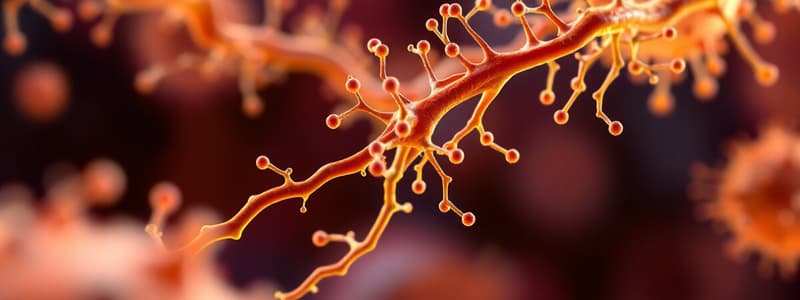Podcast
Questions and Answers
Which of the following is the correct assembly of the classical C3 convertase?
Which of the following is the correct assembly of the classical C3 convertase?
- C3b2Bb
- C4bC2a (correct)
- MBL-MASP-1
- C3bBb
What is the primary mechanism by which α-2 macroglobulin helps suppress pathogen infections?
What is the primary mechanism by which α-2 macroglobulin helps suppress pathogen infections?
- Enhancing phagocytosis of infected cells.
- Blocking viral entry into host cells.
- Inactivating proteases secreted by pathogens. (correct)
- Directly lysing bacterial cell walls.
Which of the following complement components are known as anaphylatoxins?
Which of the following complement components are known as anaphylatoxins?
- C5b and C6
- C3a and C5a (correct)
- C3b and C4b
- C2a and C4a
What is the outcome of the terminal complement components forming membrane-attack complexes (MAC)?
What is the outcome of the terminal complement components forming membrane-attack complexes (MAC)?
Which acute-phase protein binds to phosphocholine on bacterial surfaces, acting as both an opsonin and a complement activator?
Which acute-phase protein binds to phosphocholine on bacterial surfaces, acting as both an opsonin and a complement activator?
Which complement activation pathway is initiated by the binding of mannose-binding lectin to pathogen surfaces?
Which complement activation pathway is initiated by the binding of mannose-binding lectin to pathogen surfaces?
What is the primary role of C3b in complement activation?
What is the primary role of C3b in complement activation?
Which of the following best describes the sequence of activation for the three complement pathways?
Which of the following best describes the sequence of activation for the three complement pathways?
What is the function of DAF (Decay-Accelerating Factor) and MCP (Membrane Cofactor Protein) in regulating complement activation?
What is the function of DAF (Decay-Accelerating Factor) and MCP (Membrane Cofactor Protein) in regulating complement activation?
How does the complement system contribute to innate immunity?
How does the complement system contribute to innate immunity?
What is the role of CD59 protein in regulating complement activation?
What is the role of CD59 protein in regulating complement activation?
Which of the following is the correct definition of opsonization?
Which of the following is the correct definition of opsonization?
C-reactive protein (CRP) binds to what?
C-reactive protein (CRP) binds to what?
Flashcards
Alternative Pathway
Alternative Pathway
First pathway activated by pathogen surface, cleaving C3 to enhance opsonization and inflammation.
Lectin Pathway
Lectin Pathway
Second pathway initiated by mannose-binding lectin on pathogen surface, leading to C3 cleavage.
Classical Pathway
Classical Pathway
Third pathway triggered by antibody or C-reactive protein binding to pathogen, also cleaving C3.
Opsonization
Opsonization
Signup and view all the flashcards
Complement System
Complement System
Signup and view all the flashcards
DAF
DAF
Signup and view all the flashcards
CD59
CD59
Signup and view all the flashcards
C-Reactive Protein (CRP)
C-Reactive Protein (CRP)
Signup and view all the flashcards
C3 convertase
C3 convertase
Signup and view all the flashcards
Anaphylatoxins
Anaphylatoxins
Signup and view all the flashcards
Acute phase proteins
Acute phase proteins
Signup and view all the flashcards
α-2-macroglobulin
α-2-macroglobulin
Signup and view all the flashcards
Study Notes
Complement Pathways
- Alternative Pathway: Pathogen surfaces trigger complement activation. C3 is cleaved, creating C3a and C3b. This leads to inflammation (via C3a), opsonization (C3b), and pathogen lysis. It acts first.
- Lectin Pathway: Mannose-binding lectin binds to pathogen surfaces, initiating complement activation. C3 is cleaved to C3a and C3b. This leads to inflammation, opsonization, and pathogen lysis. It acts second.
- Classical Pathway: Antibodies or C-reactive protein (CRP) bind pathogen surfaces. Complement activation follows, cleaving C3 to C3a and C3b, leading to inflammation, opsonization, and pathogen lysis. It acts third.
Complement System and Innate Immunity
- The complement system is a crucial part of the innate immune response, rapidly reacting to foreign invaders.
- It's a system of ~30 proteins in blood, lymph, and extracellular fluids.
- A cascade of activation amplifies the initial response to a stimulus very quickly.
Opsonization
- Opsonization is the process where complement proteins coat pathogens, making them easier for phagocytes (immune cells) to engulf and destroy.
Complement Activation Regulation
- DAF (Decay-accelerating factor) and MCP (Membrane cofactor protein): Prevent complement activation on healthy human cells by disrupting the C3 convertase.
- CD59: Prevents the formation of the membrane attack complex (MAC) by binding to the C5b-C9 complex, essentially stopping the formation of the cell-damaging pore.
C-Reactive Protein (CRP)
- Induction: Cytokines (IL-1, IL-6, TNF-α) trigger the liver to produce CRP. Bacteria also induce CRP production.
- Production Site: Liver.
- Binding: CRP binds to phosphocholine on bacterial surfaces, acting as an opsonin and complement activator.
- Clinical Use: CRP levels in the blood are clinically monitored to detect infection and inflammation.
C3 Convertases
- Classical Pathway: C4bC2a.
- Alternative Pathway: C3bBb.
Anaphylatoxins
- C3a and C5a: These complement components act as anaphylatoxins. They promote inflammation, increase vascular permeability, stimulate mast cell degranulation (histamine release), and chemotaxis (calling immune cells to the site).
Acute Phase Proteins
- Induction: Cytokines (IL-1, IL-6, TNF-α) induce the liver to produce acute-phase proteins like CRP.
Mannose-Binding Lectin (MBL)
- MBL is a protein that binds to carbohydrates on pathogens, initiating the complement pathway.
Complement System and Infection Suppression
- Complement enhances phagocytosis by opsonization and, via the terminal complement pathway, forms the membrane attack complex (MAC).
- MAC creates pores in pathogen membranes, causing pathogen lysis (death).
α2-Macroglobulin
- α2-macroglobulin is a protein that inactivates pathogen proteases, preventing them from degrading host tissues.
Studying That Suits You
Use AI to generate personalized quizzes and flashcards to suit your learning preferences.



![Lecture 04: The Complement System and Pathways in Immunology {MCQ 1]](https://assets.quizgecko.com/cdn-cgi/image/width=300,height=200,fit=crop,quality=75,format=webp/quiz/0c9d7db8e7a538eb3326d8a833db6ee5.jpg)
![Lecture 04: Complement System Overview and Pathways [SEQ 2]](https://assets.quizgecko.com/cdn-cgi/image/width=300,height=200,fit=crop,quality=75,format=webp/quiz/e82a4175420b22396931051deb54c316.jpg)